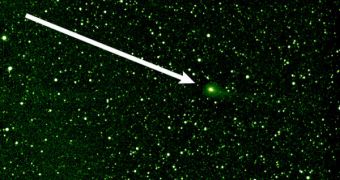NASA physicists operating the two identical Solar Terrestrial Relations Observatory (STEREO) space probes say that one of the spacecraft was able to catch a view of Comet Elening, as it was passing through deep space last week.
These two telescopes work together to produce 3D views of the Sun, but they are located very far away from each other. STEREO Ahead moves in front of Earth in its orbit around the Sun, while its sister spacecraft trails behind.
This setup allows investigators to compile in-depth images of the Sun, from angles that simply cannot be achieved by other, similar missions. However, the mission long ago proved capable of exceeding its original tasks, and was heavily used to conduct other astronomical studies as well.
Last week, NASA experts rolled STEREO-B from its standard orbit, so that it captured a series of pictures depicting Comet Elenin. The object was 4.3 million miles (7 million kilometers) away at its point of closest approach, Space reports.
Comet Elenin (C/2010 X1) was first identified on December 10, 2010, by amateur Russian astronomer Leonid Elenin. Its discoverer was using the International Scientific Optical Network's (ISON) robotic observatory, near Mayhill, New Mexico, in the US.
Subsequent studies demonstrated that this is a long-period comet, which means that it has a highly eccentric orbit, as well as a period ranging from 200 years to millions of years. The nucleus of the comet itself is 3 to 4 kilometers in diameter.
In order to collect the new photos, experts used Stereo B's HI-2 telescope between August 1-5 and then switched to the probe's higher-resolution telescope, HI-1, between August 6-12.
“From August 15 onward, the comet enters the HI-1 telescope's nominal field of view, at which time we should enjoy continuous viewing of the comet,” a Stereo mission website post explains.
The reason why this object is of interest is that it will pass through the inner solar system around October 2011. At its point of closest approach, the space body will fly around 22 million miles away from Earth. For comparison, our planet is 93 million miles away from the Sun.
NASA experts plan to continue conducting observations of Comet Elenin using the Solar and Heliospheric Observatory (SOHO), which is also dedicated to studying the Sun. The research will begin on September 23, and will last for about 6 days.

 14 DAY TRIAL //
14 DAY TRIAL //